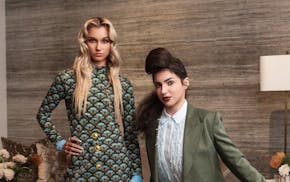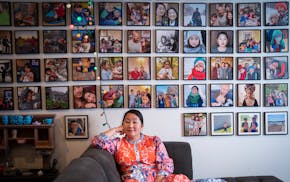It is no exaggeration to say that without "The Mary Tyler Moore Show," writer Julie Marie Wade's life might have turned out very differently.
Since the Florida professor discovered the classic sitcom in 1992 reruns, she has marked important points in her life by referencing similar moments from the show.
Wade, 45, graduated from watching the Minneapolis-set series on grainy videos she taped from TV as a kid to a DVD set. But, through it all, she was guided by a What Would Mary Tyler Moore do ethos, which she documents in "The Mary Years." Wade will read from the collection of essays when she appears next month at Magers & Quinn bookstore in Minneapolis.
Growing up in a fundamentalist Christian family and not yet aware she was a lesbian, Wade felt like an outsider at home and at school. But she instantly felt kinship with Moore's character, a news producer named Mary Richards, a single woman who built a family of friends.
"I was about to turn 13 or had just turned 13 and I was really hungry for female role models and ways to imagine myself into a future," said Wade, an English professor at Florida International University. "When you are 13, 30 [Richards' age when the series began in 1970] sounds so far away. So, I knew I had a long way to go before my Mary years would start."
The show addressed lots of questions Wade was just starting to ask: "Who did I want to be at 30? Where did I want to be? Just the idea of having my own place was radical. I couldn't imagine it. And a circle of friends!"
Wade didn't lust after Moore (around the same time, she had a "fluttery feeling" that she came to realize was a big ol' crush on Elizabeth Montgomery of "Bewitched"), but she saw Mary Richards' life as something she could work toward. Richards demonstrated a life that included a career and friends, one that didn't revolve around male companionship.
Wade wasn't sure what the "fluttery feeling" was back then but she sensed it was something her family wouldn't approve of and that she should keep to herself. So, it was a relief that she loved Mary Richards but didn't get that feeling from her.
"It was much more about esteem, respect, admiration. It was, 'Oh, thank God, I'm not going to fall in love with you. I just want to be like you,' " said Wade.
Wade continued to measure her life against Mary Richards', always discovering new meaning in the show. She didn't come out until grad school, when she met Angie Griffin, who's still her partner, an experience that helped her take another look at aspects of the show that the 13-year-old, thinking-she-was-straight version of Wade might have been puzzled about.
There is, for instance, a 1973 episode in which Richards' landlady, Phyllis (Cloris Leachman), worries her erudite brother is embarking on a romance with Rhoda (Valerie Harper). Mary loves Rhoda but Phyllis, who does not, is relieved to learn her brother isn't interested in Rhoda — because he's interested in men.
"It registered so clearly with me when Rhoda says, 'Phyllis, he's gay.' That was not a problem for Rhoda. Or for Mary. So, they could have a gay friend. Could I be their gay friend?" asked Wade. "It took me until college to realize I wanted to be the Phyllis brother in that situation. But [it was] the revelation that they weren't going to have a pulling-your-hand-away-from-a-hot-stove reaction, which was the reaction everyone in my family would have had. I was watching this and thinking about the possibilities for my life."
Episodes such as Wade's current favorite, "Mary's Insomnia," a 1976 episode from the final season, registered differently when Wade was an adult with similar struggles: "As a person who has experienced lots of insomnia since 2015, [the episode is] a comfort for me, a go-to. Even Mary has insomnia."
Around the time Moore died in 2017, Wade began writing essays about the shared signposts of her own and Richards' lives: realizing you could live far away from your family; that they didn't have to know about or approve of everything you did; that it was OK to make choices they'd disdain. Wade was writing the essays for herself but, when they appeared in literary journals, she realized their appeal was broader.
"These little pieces of it started getting published and editors would say, 'By the way, I'm a huge fan of "The Mary Tyler Moore Show."' So, I started to think, maybe this is bigger than I thought. Maybe people would be interested in my idiosyncratic journey because they had their own and they might be interested in talking about that," said Wade.
Wade found out that a publisher had accepted "The Mary Years" while she was hanging out in a park like the one Mary walks past in the opening credits of the series. Wade and Angie have come to Minneapolis a couple of times to visit the places where Mary hung out, to be in the epicenter of WWMTMD — including a long walk from downtown to the Kenwood home where Mary supposedly lived in the series' early seasons.
Wade's looking forward to her December trip here, when she'll read from her book and pay tribute to the show, episodes of which are streaming on several services. Wade thinks the show has endured because "people can find in Mary someone who's still trying to navigate doing a good job at work, being a good friend to people, even people who may not like each other or who are difficult."
Friends of Wade have learned to live with her constantly referencing "The Mary Tyler Moore Show." One of her graduate students even crocheted her a replica of the hat Moore tosses in the air at the end of the opening credits. Wade will be bringing it with her next month, and there's a pretty good chance it'll be tossed, too, in tribute to the icon who helped her envision the path to the woman she has become.
The Mary Years
By: Julie Marie Wade
Publisher: Texas Review Press, 172 pages, $19.95.
Event: 7 p.m. Dec. 5, Magers & Quinn, 3038 Hennepin Av., Mpls. Free but registration required.

These 5 Twin Cities area fashion shows celebrate spring

The Big Gigs: 10 best concerts to see in the Twin Cities this week
Stuck for hours on a parked plane? Here are your rights.
Review: In Minneapolis writer Kate DiCamillo's 'Orris and Timble,' an owl and a rat are pals



